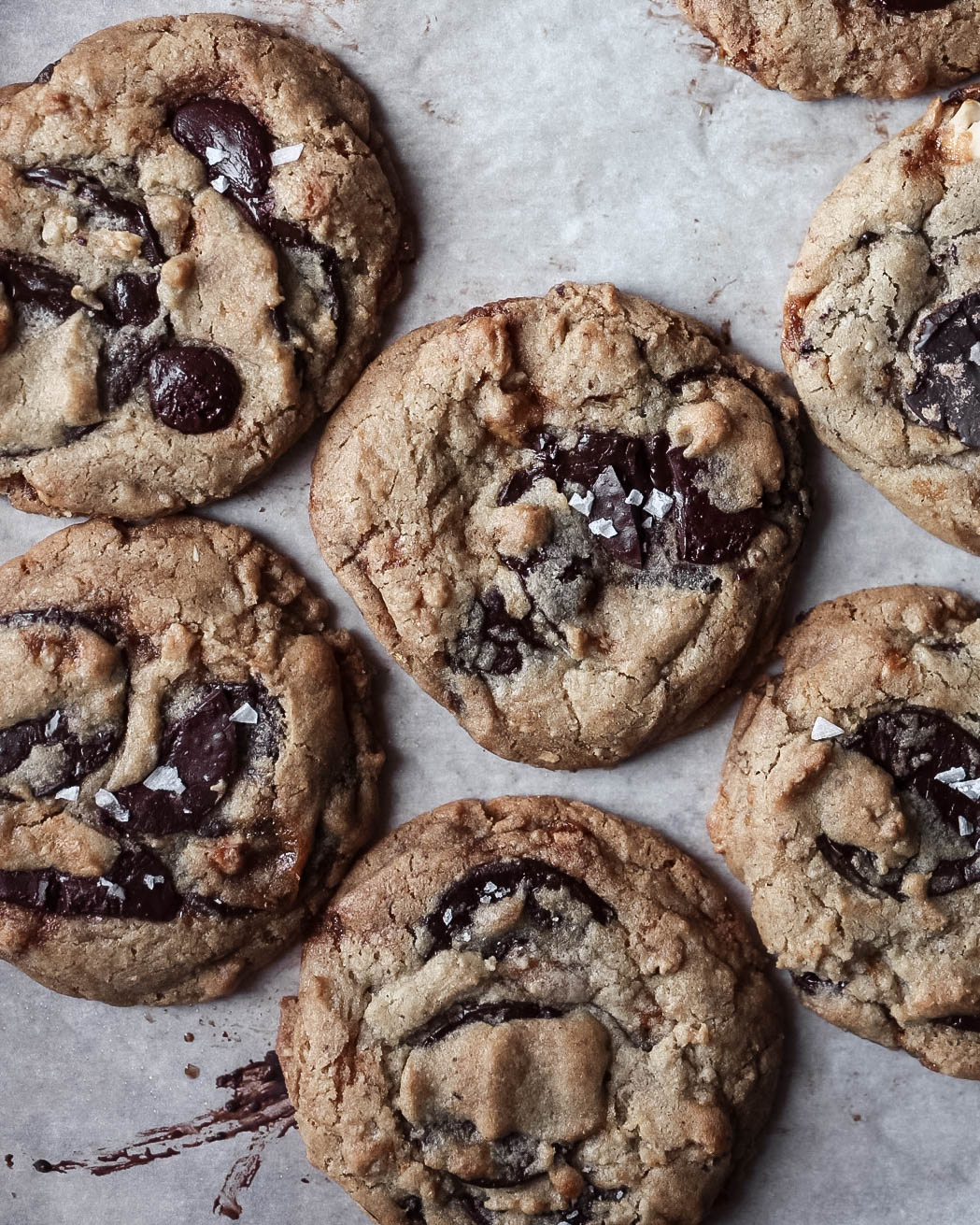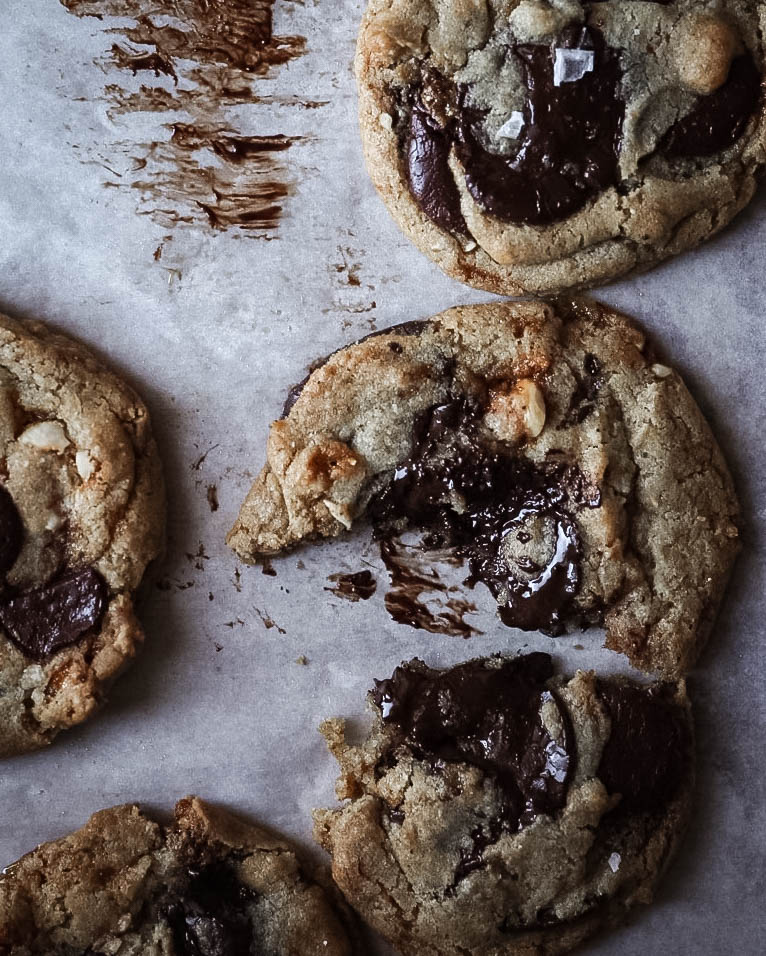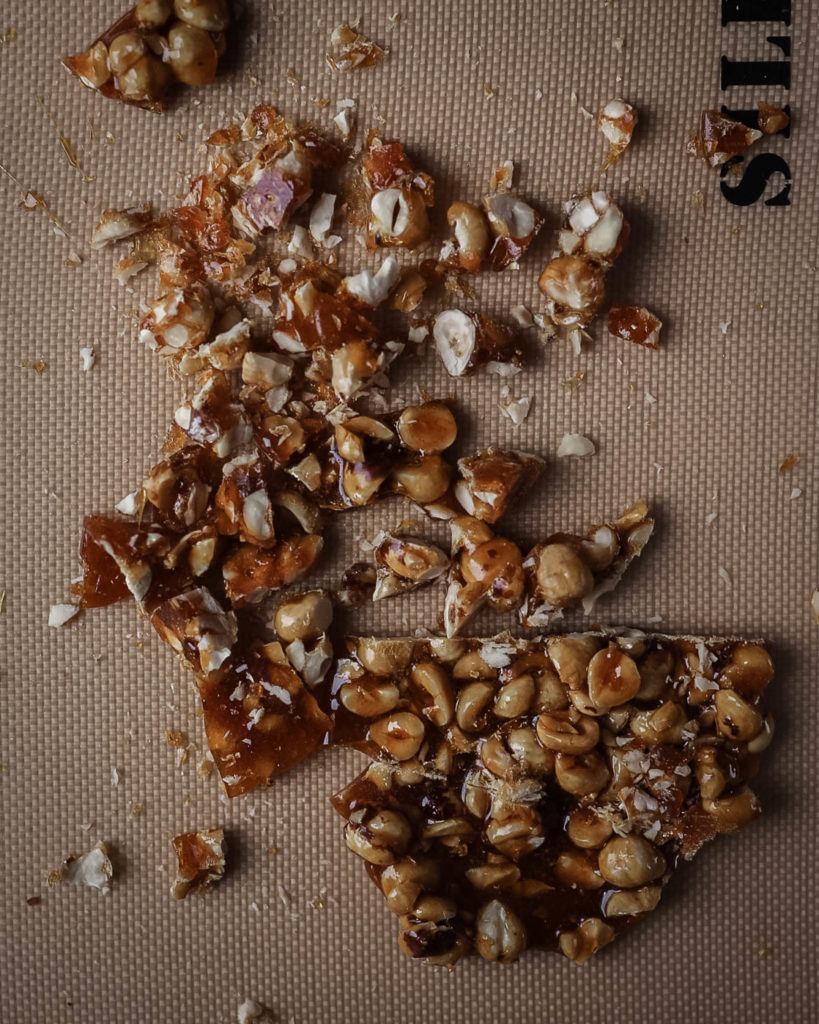Chocolate Chunk, Rye, and Hazelnut Praline Cookies

There are a few baking bloggers who consistently inspire me with interesting flavor profiles and genius twists on classic pastries. Claudia Brick is one whom I’ve mentioned before, and whose brioche scrolls inspired one of the first recipes on this blog. She also has a gorgeous aesthetic–she was one of the first baking bloggers I followed on Instagram.
Another baking blogger whose flavors and visual aesthetic consistently entice me is Thalia Ho of Butter and Brioche. Months and months ago, I was seduced by her Hazelnut Praline and Rye Chocolate Chunk Cookies. The cookies were particularly intriguing because, unlike most chocolate chunk cookies I’ve encountered, they used a dough made with melted butter. Well, I whipped up a batch and the flavors were, indeed, lovely. But, as to the cookies themselves, I have to admit, I was not completely satisfied. Don’t get me wrong–they were definitely tasty, the hazelnut-chocolate-rye combo was perfection, and yet . . . I wanted more texture, more caramelization, more depth. Basically, I wanted the famous Jacques Torres chocolate chip cookies. But with rye, and hazelnut praline.

For those of you who don’t know what I’m talking about (have you been living under a rock?), Jacques Torres is a famous patissier who created a deservedly legendary chocolate chip cookie. Really, a chocolate layer cookie–rather than chips, the cookie is made with chocolate discs or feves, which melt into ridiculous layers of molten chocolate. But the real key to the recipe is the technique: After mixing the dough, you let it rest in the refrigerator for 24-72 hours before shaping the cookies and baking. This resting period, as I understand it, allows the ingredients to better incorporate and meld together, which leads to more intense caramelization and flavor when the cookies are finally baked.
The recipe below is actually adapted, not from the original Jacques Torres recipe, but from an adaptation by David Leite in the New York Times, which as become almost as famous as the original. I’ve followed the New York Times in using a combination of bread flour and cake flour, but reduced the amounts for both and added a good dose of rye flour. Can you use all-purpose flour instead of the bread flour/cake flour combo? My friend Tony insists that in Leite’s recipe, it works just as well. Deb Perelman agrees. Me? I’ve tried the original both ways, and, maybe it’s all in my head, but I prefer the bread flour/cake flour combination, so I stuck with that.
The hazelnut praline uses what I call a “cheater’s caramel”–a tiny bit of corn syrup helps keep the sugar from crystallizing. Don’t be intimidated by “caramel.” One reason it took me so long to test and post this recipe is that I felt daunted by the extra step of making the praline. But once I actually just DID it, I was reminded that making a simple praline like this is actually super quick and easy.

For the cookies themselves, one technique I have carried over from Thalia Ho’s recipe is “pan-banging”–an innovation of another fantastic food blogger, Sarah Kieffer. Basically, after the cookies are halfway done baking, you open the oven door and bang the cookie sheet down against the oven rack, which helps the melting chocolate discs spread into delicious pools of chocolate goodness. It sounds weird, but it works.
There are two non-negotiable elements of this recipe: (1) You must use good bittersweet or dark chocolate–but if you’ve managed to find discs or feves, you’ve most likely succeeded on that score. (2) You MUST let the dough rest in the refrigerator for at least 24 hours, and preferably 36. Trust me. It’s worth it.

Chocolate Chunk, Rye, and Hazelnut Praline Cookies
Adapted from David Leite in the New York Times Food section. Inspired by Thalia Ho.
Ingredients
For the hazelnut praline
- 2/3 cup toasted, skinned, chopped hazelnuts
- 1/2 cup (100 g / 3.5 oz) sugar
- 1 tsp light corn syrup
- 2 tbsp water
- pinch salt
For the cookies
- 6 oz. cake flour
- 6 oz. bread flour
- 5 oz. rye flour
- 1 1/4 tsp kosher salt
- 1 1/4 tsp baking soda
- 1 1/2 tsp baking powder
- 10 oz unsalted butter at room temperature
- 10 oz light brown sugar
- 8 oz granulated sugar
- 2 large eggs
- 2 tsp vanilla extract
- 1 lb. bittersweet chocolate discs or feves – plus a handful extra for the tops of the cookies
- flaky sea salt
Instructions
Make the hazelnut praline:
-
Line a baking sheet with a silicone mat or parchment paper
-
In a heavy skillet or saucepan, combine the sugar, corn syrup, and water, and cook over medium high heat, without stirring, until the mixture begins to slightly color.
-
Swirl the pan (don't stir), and continue cooking the sugar mixture, swirling occasionally, until the caramel is an even, deep amber color. This will only take a few minutes.
-
Remove this caramel from the heat, use a silicone or rubber spatula to quickly stir in the chopped nuts and a pinch of salt, and then turn the mixture out onto the lined baking sheet, using the spatula to spread it in an even layer.
-
Allow the praline to cool and harden, and then transfer it to a cutting boar and chop it into small-ish pieces with a sharp knife.
Make the cookie dough:
-
Sift the three flours, baking soda, and baking powder together into a medium bowl, and whisk in the salt. Set aside.
-
In an electric stand mixer fitted with the paddle attachment, cream the butter, brown sugar, and granulated sugar until light and fluffy. Add the eggs, one at a time, beating well after each addition. Mix in the vanilla.
-
With the mixer on low speed, add the flour mixture, and mix until just combined. (This should only take 10 seconds or so.)
-
Add 1 lb. of chocolate discs or feves and the chopped hazelnut praline, and mix on low speed to slightly distribute the additions. Then, turn off and remove the bowl from the mixer, and use a sturdy silicone or rubber spatula to finish incorporating the chocolate pieces and hazelnut praline.
-
Cover the bowl with plastic wrap and refrigerate for at least 24 hours, preferably 36 hours, and up to 72 hours.
-
When you are ready to bake the cookies, line two baking sheets with parchment paper or silicone mats, and preheat the oven to 350 F.
Using an ice cream scooper or large spoon, scoop 6-8 mounds of dough–about 70 grams each–onto the first cookie sheet. If you are pro-chocolate-puddle (and, really, who isn't?), nestle an extra chocolate feve or two into the top of each mound of dough.
Repeat with the second cookie sheet.
-
Place one cookie sheet in the oven, and bake the cookies for approximately 18-20 minutes. Halfway through the baking time, open the oven and (with oven-mitt-protected hands!) bang the baking sheet against the oven rack. Close the oven, and then, one minute later, bang the pan again. Repeat this pan-banging 2 more times (for a total of four times), at one minute intervals.
When the cookies are golden brown and the chocolate is molten, remove the cookies from the oven. Sprinkle flaky sea salt over the molten puddles of chocolate, and let the cookies cool on the pan for 5 minutes before transferring them to a wire rack to cool completely.
-
Meanwhile, bake the second sheet of cookies, following the process above.
-
When both sheets are baked, you can repeat the process with the remaining cookie dough, leave the remaining dough in the fridge and bake another batch or two over the next couple of days, or scoop out and freeze the remaining dough to bake cookies at a later date.
Recipe Notes
- “Can I use 12 oz. of regular flour instead of the mix of bread and cake flours?” A reliable authority suggests that you can, though I’ve remain partial to the flour mix called for in Leite’s original recipe.
- What’s the point of the 24-72 hour refrigerator rest? As discussed in my blog post above, the resting period in the fridge allows the ingredients–especially the moisture in the eggs–to better incorporate, and ultimately facilitates the caramelization that gives these cookies their depth of flavor.
- As noted in the recipe above, once the dough has been sufficiently “aged,” you can scoop out cookies and freeze them for future baking. Some of you may be wondering whether you can just scoop out and freeze the cookies immediately after mixing the dough–I did try it that way, and the results just are not as good as when you allow the dough to “age” in the refrigerator first.
- The baked cookies also freeze well.
1 thought on “Chocolate Chunk, Rye, and Hazelnut Praline Cookies”